初中英语常用课堂教学用语
- 格式:docx
- 大小:13.76 KB
- 文档页数:9

英语阅读课评课常用语亮点:1.本节阅读课教学设计符合新课程标准理念。
教学过程完整,教学目标明确,教学活动由浅入深,环环相扣。
具体表现在:1).通过提问的方式,用图片视频导入,不但调动了学生学习的兴趣,也激活了学生已有的图式,为阅读教学进一步的铺垫。
2).能设计多种题型来训练学生的阅读能力,符合学生的实际。
3).小组讨论引导学生利用已知信息构想和创设新的信息,有利于培养学生综合运用语言的能力。
4).情感教学的渗透,及时的小结和反馈是另一个亮点。
2.本节课符合本学科的教学要求及阅读课型。
老师结合学生的实际来设计及开展教学。
以学生熟悉的卡通人物激起学习兴趣,采取了分层教学,由浅入深,结构合理,面向全体学生并照顾差异,重难点突出,既训练了学生的阅读能力,同时又训练了学生的听说能力。
在本节课中,学生积极参与课堂活动,踊跃回答问题。
教学效果良好,目标达成。
这节阅读课教学目标明确,能够根据学情来设计,切合学生实际。
总体来说有:1).课堂以学生感兴趣的图片以及视频动画来引出本节课的主题,这样可以很好地激发学生的学习热情。
2).阅读课型特征明显,并进行分层阅读,整节课的教学策略都是以任务型教学为主,明确每一个环节的教学目的。
3).在每一个教学环节中教师都有一些微技能的渗透,且不停提示学生解题技巧。
4).注重学生的反馈(学生举手;利用不同颜色的字母卡)。
3.这一堂课是一堂实在,系统扎实,动静结合的英语课。
教师以新的课程理念为指导,充分考虑了学生这一年龄阶段的特点,在本课的教学设计和组织上注重了以下几个方面。
1.视频导入,充分调动起学生兴趣。
良好的开头对一堂课的成功与否,起着关键的作用。
本堂课一开始,教师就用视频导入新课,使学生的注意力在最短的时间里,被激活。
2.本堂课上,老师很好的贯彻了:在用中学,学中用,学用结合,学以致用的原则。
同时体现了以学生为主体,教师为主导的新课程理念。
在这样的一个学习过程中,学习者处于相对自然的态势,不断的在习得和使用语言,学和用每分每秒都和谐的交织在一起。
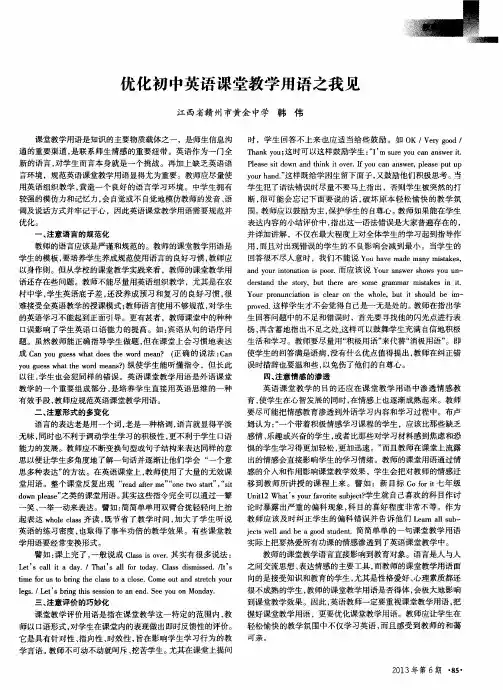
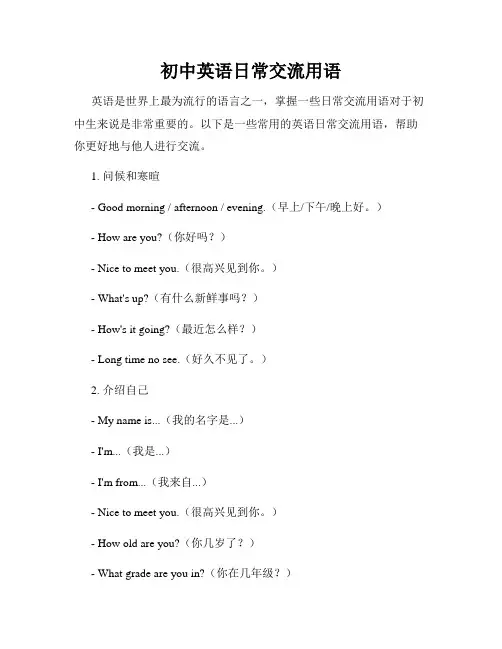
初中英语日常交流用语英语是世界上最为流行的语言之一,掌握一些日常交流用语对于初中生来说是非常重要的。
以下是一些常用的英语日常交流用语,帮助你更好地与他人进行交流。
1. 问候和寒暄- Good morning / afternoon / evening.(早上/下午/晚上好。
)- How are you?(你好吗?)- Nice to meet you.(很高兴见到你。
)- What's up?(有什么新鲜事吗?)- How's it going?(最近怎么样?)- Long time no see.(好久不见了。
)2. 介绍自己- My name is...(我的名字是...)- I'm...(我是...)- I'm from...(我来自...)- Nice to meet you.(很高兴见到你。
)- How old are you?(你几岁了?)- What grade are you in?(你在几年级?)3. 问询他人- Where are you from?(你来自哪里?)- What's your name?(你叫什么名字?)- How old are you?(你几岁了?)- What grade are you in?(你在几年级?)- Do you have any hobbies?(你有什么爱好?)4. 询问关于日常生活的问题- What's the time?(现在几点了?)- What day is it today?(今天星期几?)- Do you have any plans for the weekend?(周末有什么计划?)- What did you do yesterday?(昨天你做了什么?)- What's your favorite subject in school?(学校里你最喜欢的科目是什么?)5. 表达个人喜好和兴趣- I like...(我喜欢...)- My favorite color is...(我最喜欢的颜色是...)- I enjoy...(我喜欢...)- I love...(我热爱...)- I'm interested in...(我对...感兴趣。
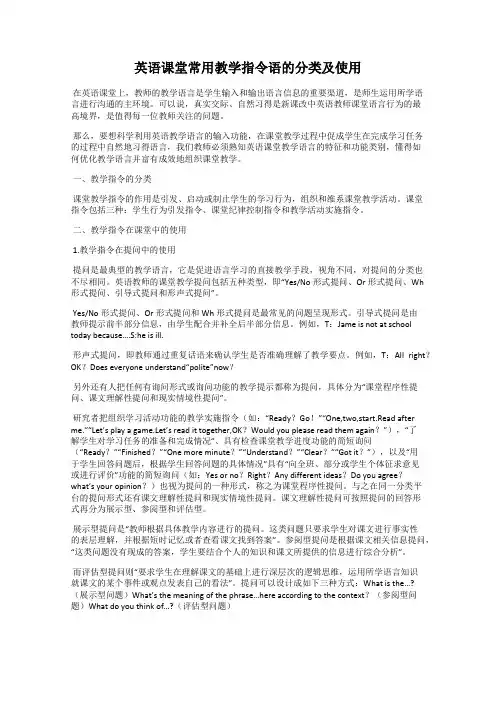
英语课堂常用教学指令语的分类及使用在英语课堂上,教师的教学语言是学生输入和输出语言信息的重要渠道,是师生运用所学语言进行沟通的主环境。
可以说,真实交际、自然习得是新课改中英语教师课堂语言行为的最高境界,是值得每一位教师关注的问题。
那么,要想科学利用英语教学语言的输入功能,在课堂教学过程中促成学生在完成学习任务的过程中自然地习得语言,我们教师必须熟知英语课堂教学语言的特征和功能类别,懂得如何优化教学语言并富有成效地组织课堂教学。
一、教学指令的分类课堂教学指令的作用是引发、启动或制止学生的学习行为,组织和维系课堂教学活动。
课堂指令包括三种:学生行为引发指令、课堂纪律控制指令和教学活动实施指令。
二、教学指令在课堂中的使用1.教学指令在提问中的使用提问是最典型的教学语言,它是促进语言学习的直接教学手段,视角不同,对提问的分类也不尽相同。
英语教师的课堂教学提问包括五种类型,即“Yes/No形式提问、Or形式提问、Wh形式提问、引导式提问和形声式提问”。
Yes/No形式提问、Or形式提问和Wh形式提问是最常见的问题呈现形式。
引导式提问是由教师提示前半部分信息,由学生配合并补全后半部分信息。
例如,T:Jame is not at school today because….S:he is ill.形声式提问,即教师通过重复话语来确认学生是否准确理解了教学要点。
例如,T:All right?OK?Does everyone understand“polite”now?另外还有人把任何有询问形式或询问功能的教学提示都称为提问,具体分为“课堂程序性提问、课文理解性提问和现实情境性提问”。
研究者把组织学习活动功能的教学实施指令(如:“Read y?Go!”“One,two,start.Read after me.”“Let’s play a game.Let’s read it together,OK?Would you please read them again?”),“了解学生对学习任务的准备和完成情况”、具有检查课堂教学进度功能的简短询问(“Ready?”“Finished?”“One more minute?”“Understand?”“Clear?”“Got it?”),以及“用于学生回答问题后,根据学生回答问题的具体情况”具有“向全班、部分或学生个体征求意见或进行评价”功能的简短询问(如:Yes or no?Right?Any different ideas?Do you agree?what’s your opinion?)也视为提问的一种形式,称之为课堂程序性提问。
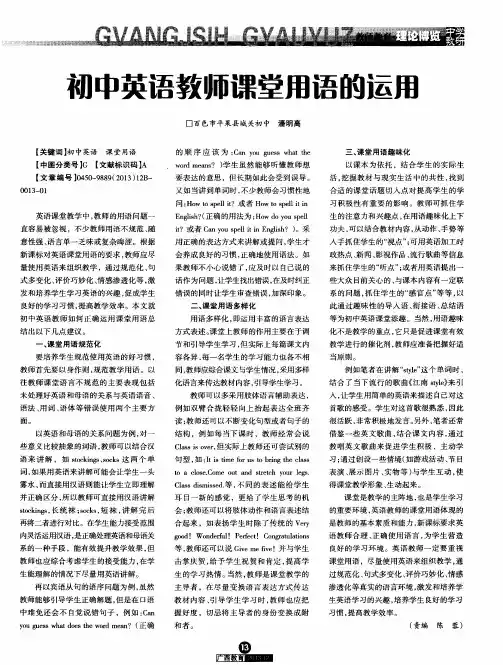
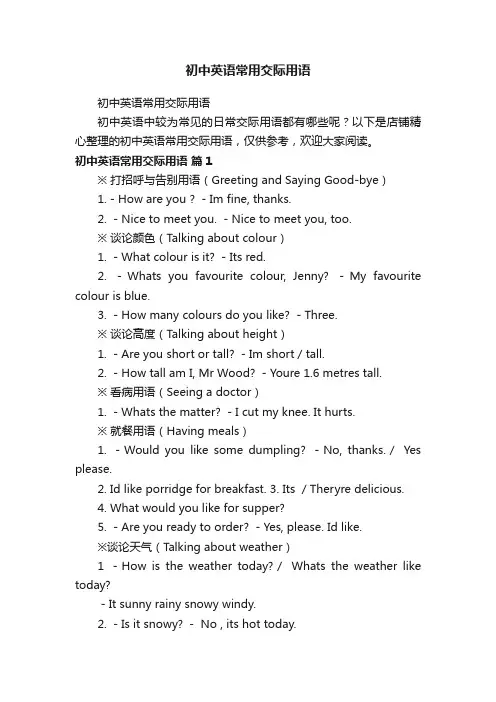
初中英语常用交际用语初中英语常用交际用语初中英语中较为常见的日常交际用语都有哪些呢?以下是店铺精心整理的初中英语常用交际用语,仅供参考,欢迎大家阅读。
初中英语常用交际用语篇1※ 打招呼与告别用语(Greeting and Saying Good-bye)1.-How are you ? -Im fine, thanks.2. -Nice to meet you. -Nice to meet you, too.※ 谈论颜色(Talking about colour)1. -What colour is it? -Its red.2. -Whats you favourite colour, Jenny? -My favourite colour is blue.3. -How many colours do you like? -Three.※ 谈论高度(Talking about height)1. -Are you short or tall? -Im short/tall.2. -How tall am I, Mr Wood? -Youre 1.6 metres tall.※ 看病用语(Seeing a doctor)1. -Whats the matter? -I cut my knee. It hurts.※ 就餐用语(Having meals)1. -Would you like some dumpling? -No, thanks./Yes please.2. Id like porridge for breakfast.3. Its /Theryre delicious.4. What would you like for supper?5. -Are you ready to order? -Yes, please. Id like.※谈论天气(Talking about weather)1 -How is the weather today?/Whats the weather like today?-It sunny rainy snowy windy.2. -Is it snowy? - No , its hot today.※日常交流That rings a bell. 我总算想起来了。

初中初一英语课堂教师指令用语教学英语课堂中,教师的指令用语是学生们学习和参与课堂活动的重要环节。
通过准确、清晰的指令用语,教师能够有效地引导学生的学习,激发学生的兴趣,并帮助他们更好地理解英语知识。
本文将从指令用语的重要性、常用的指令用语及应用场景等方面展开论述。
一、指令用语的重要性指令用语在英语教学中起着至关重要的作用。
首先,准确的指令用语可以帮助学生明确任务和要求,从而更好地完成学习任务。
例如,当教师使用“Open your books to page 10”这样的指令用语时,学生清楚地知道自己需要做的是翻到教材的第10页。
其次,指令用语还能够提高学生的课堂参与度。
使用指令用语可以有效地组织课堂活动,让学生积极参与,提高学习效果。
最后,指令用语在培养学生的语言表达能力方面也非常重要。
通过模仿和学习教师的指令用语,学生可以提高自己的口语表达能力,并学会在交流中使用正确的表达方式。
二、常用的指令用语及应用场景1. 给出任务和要求(1) Listen carefully and take notes.(认真听讲并做笔记。
)(2) Work in pairs/groups.(两人/小组合作。
)(3) Read the passage aloud.(大声朗读课文。
)(4) Complete the exercise individually.(独立完成练习。
)(5) Write down the answer on your paper.(把答案写在你的纸上。
)这些指令用语常用于告诉学生需要进行的具体任务和要求。
通过这些指令用语,学生可以明确地知道自己需要做什么。
2. 提问和引导讨论(1) What's the answer?(答案是什么?)(2) Can anyone give me an example?(有人能给我一个例子吗?)(3) What do you think?(你认为呢?)(4) How do you understand this sentence?(你理解这句话吗?)(5) What's the main idea of this passage?(这篇文章的主要内容是什么?)这些指令用语常用于提问和引导学生思考、表达自己的观点。
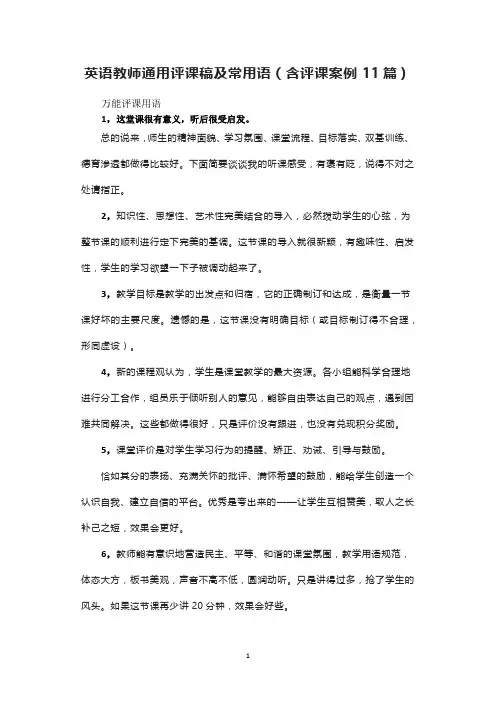
英语教师通用评课稿及常用语(含评课案例11篇)万能评课用语1,这堂课很有意义,听后很受启发。
总的说来,师生的精神面貌、学习氛围、课堂流程、目标落实、双基训练、德育渗透都做得比较好。
下面简要谈谈我的听课感受,有褒有贬,说得不对之处请指正。
2,知识性、思想性、艺术性完美结合的导入,必然拨动学生的心弦,为整节课的顺利进行定下完美的基调。
这节课的导入就很新颖,有趣味性、启发性,学生的学习欲望一下子被调动起来了。
3,教学目标是教学的出发点和归宿,它的正确制订和达成,是衡量一节课好坏的主要尺度。
遗憾的是,这节课没有明确目标(或目标制订得不合理,形同虚设)。
4,新的课程观认为,学生是课堂教学的最大资源。
各小组能科学合理地进行分工合作,组员乐于倾听别人的意见,能够自由表达自己的观点,遇到困难共同解决。
这些都做得很好,只是评价没有跟进,也没有兑现积分奖励。
5,课堂评价是对学生学习行为的提醒、矫正、劝诫、引导与鼓励。
恰如其分的表扬、充满关怀的批评、满怀希望的鼓励,能给学生创造一个认识自我、建立自信的平台。
优秀是夸出来的——让学生互相赞美,取人之长补己之短,效果会更好。
6,教师能有意识地营造民主、平等、和谐的课堂氛围,教学用语规范,体态大方,板书美观,声音不高不低,圆润动听。
只是讲得过多,抢了学生的风头。
如果这节课再少讲20分钟,效果会好些。
7,传统课堂的特征是“教师讲、学生听,教师说、学生记”,关注的是教师的教,新课改强调关注学生的学。
按照学生的思路去设计教学,还是按照教师的思路去照本宣科,这是教学指导思想的问题。
这节课的教学指导思想还有待进一步解放,直到彻底解放学生,让学生自主学习。
8,学生能够自学的内容,利用对子检测过关;小组内能够解决的问题,不用拿到班内展示;学生能够自己表达的,教师要鼓励学生表达。
总之,教师要相信学生、利用学生。
本节课的知识点,老师讲得面面俱到,使得学习效率难以提高。
9,某某环节创设情境,引领学生在探究中体验,在体验中探究,学生的兴趣高涨,满足了学生的好奇心,激活了学生的表现欲。
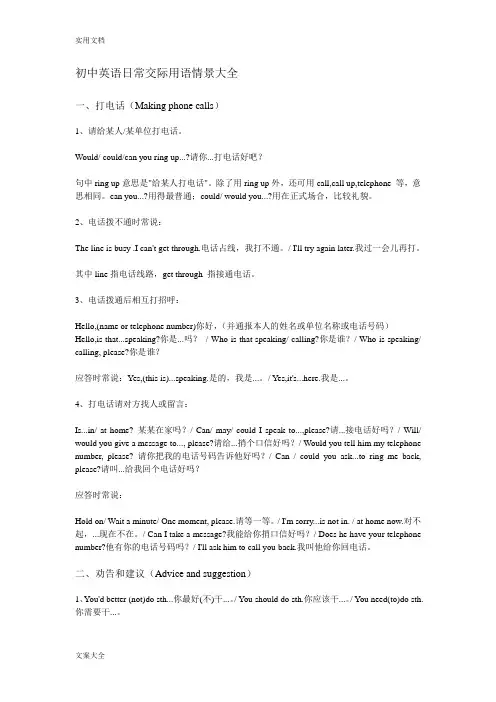
初中英语日常交际用语情景大全一、打电话(Making phone calls)1、请给某人/某单位打电话。
Would/ could/can you ring up...?请你...打电话好吧?句中ring up意思是"给某人打电话"。
除了用ring up外,还可用call,call up,telephone 等,意思相同。
can you...?用得最普通;could/ would you...?用在正式场合,比较礼貌。
2、电话拨不通时常说:The line is busy .I can't get through.电话占线,我打不通。
/ I'll try again later.我过一会儿再打。
其中line指电话线路,get through 指接通电话。
3、电话拨通后相互打招呼:Hello,(name or telephone number)你好,(并通报本人的姓名或单位名称或电话号码)Hello,is that...speaking?你是...吗?/ Who is that speaking/ calling?你是谁?/ Who is speaking/ calling, please?你是谁?应答时常说:Yes,(this is)...speaking.是的,我是...。
/ Yes,it's...here.我是...。
4、打电话请对方找人或留言:Is...in/ at home? 某某在家吗?/ Can/ may/ could I speak to...,please?请...接电话好吗?/ Will/ would you give a message to..., please?请给...捎个口信好吗?/ Would you tell him my telephone number, please? 请你把我的电话号码告诉他好吗?/ Can / could you ask...to ring me back, please?请叫...给我回个电话好吗?应答时常说:Hold on/ Wait a minute/ One moment, please.请等一等。
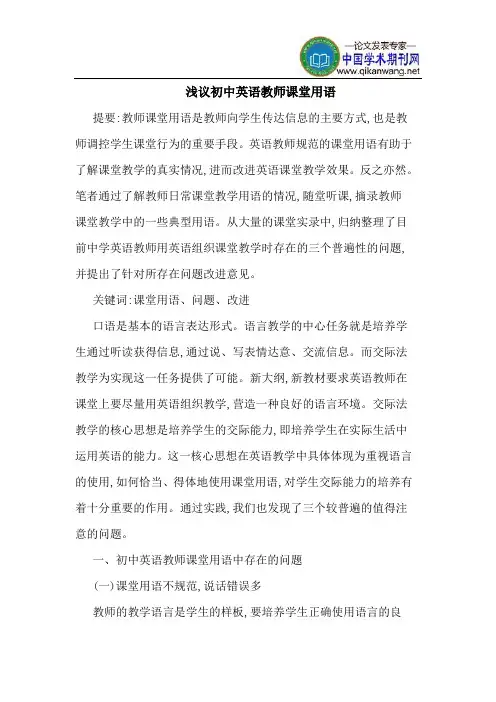
浅议初中英语教师课堂用语提要:教师课堂用语是教师向学生传达信息的主要方式,也是教师调控学生课堂行为的重要手段。
英语教师规范的课堂用语有助于了解课堂教学的真实情况,进而改进英语课堂教学效果。
反之亦然。
笔者通过了解教师日常课堂教学用语的情况,随堂听课,摘录教师课堂教学中的一些典型用语。
从大量的课堂实录中,归纳整理了目前中学英语教师用英语组织课堂教学时存在的三个普遍性的问题,并提出了针对所存在问题改进意见。
关键词:课堂用语、问题、改进口语是基本的语言表达形式。
语言教学的中心任务就是培养学生通过听读获得信息,通过说、写表情达意、交流信息。
而交际法教学为实现这一任务提供了可能。
新大纲,新教材要求英语教师在课堂上要尽量用英语组织教学,营造一种良好的语言环境。
交际法教学的核心思想是培养学生的交际能力,即培养学生在实际生活中运用英语的能力。
这一核心思想在英语教学中具体体现为重视语言的使用,如何恰当、得体地使用课堂用语,对学生交际能力的培养有着十分重要的作用。
通过实践,我们也发现了三个较普遍的值得注意的问题。
一、初中英语教师课堂用语中存在的问题(一)课堂用语不规范,说话错误多教师的教学语言是学生的样板,要培养学生正确使用语言的良好习惯,教师首先应该给学生做出榜样,但是在观察中,我记录了一些不规范的言语:1、搭配不全please listen the tape.when shall we discuss ?正确:please listen to the tape.when shall we discuss it ?2、语态不通 the letter \“e \” pronounces正确:the letter \“e\” is pronounced3、词序不对:eg.:can you tell me when did you leave home this morning? can you guess what does it mean?正确: can you tell when you left home this morning? can you guess what it mean?4、习惯性错误:eg.:teacher: what’s your name?student: joeyteacher: how to spell it?正确:how do you spell the name?经过分析总结,我发现,教师出现的错误多为单复数混用,动词短语搭配不当等,出现这些错误的主要原因是因为教师说话的语速过快,造成一些口误;还有一些是因为教师没有重视自己的课堂用语。
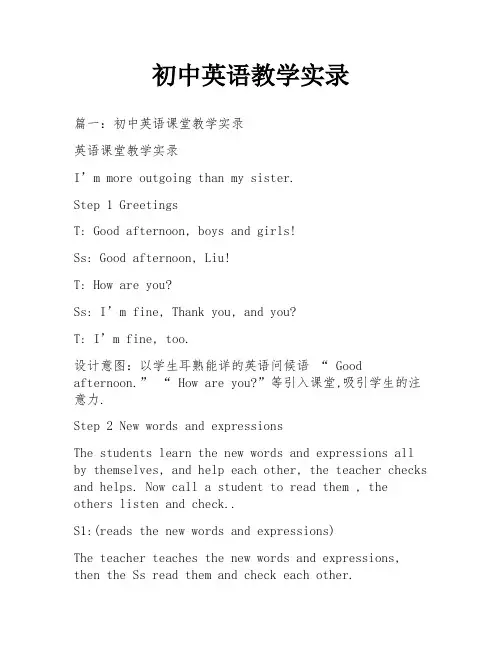
初中英语教学实录篇一:初中英语课堂教学实录英语课堂教学实录I’m more outgoing than my sister.Step 1 GreetingsT: Good afternoon, boys and girls!Ss: Good afternoon, Liu!T: How are you?Ss: I’m fine, Thank you, and you?T: I’m fine, too.设计意图:以学生耳熟能详的英语问候语“ Good afternoon.” “ How are you?”等引入课堂,吸引学生的注意力.Step 2 New words and expressionsThe students learn the new words and expressions all by themselves, and help each other, the teacher checks and helps. Now call a student to read them , the others listen and check..S1:(reads the new words and expressions)The teacher teaches the new words and expressions, then the Ss read them and check each other.设计意图:单词的教学,由学生自已拼读——互相检查帮助——教师检查辅导等方式方法改变原来单一的教师教学生跟着读,容易激发学生的积极性,且掌握得更好。
真正地体现学生的自学互帮与老师的导学。
Step 3 PresentationT: Please look at the picture.Ss:Tall.T: Very Good. Yao Ming is___________S2:Taller.T: Yao Ming is taller than Jordan.S3: Wu Yi is quieter than Tan Jiexi ..S4:. Grey Wolf is wilder than Happy Goat .Jordan is___________S5: Zhao Benshanis funnier than Bai Yansong.S6: Bob is heavier than Tom.S7: Fei Mao is fatter than Liu Huan ..S8:. Zhao Wei’s eyes are bigger than Zhou Xun’s.T: Excellent! All of you have a good memory. Now all of you make dialogues “Would you like…? Let’s…” with your partners, then act in the front of the classroom.(Five minutes later)Call some groups to act out their dialogues.设计意图:教师利用多媒体的教学资源,从学生熟悉的话题入手,初步了解形容词比较级的用法,生活化课堂自然生成.]Step4 Match the words with opposites..Step5 Listen and number the pair of twins [1-3] in the picture.设计意图:整个过程,学生都处在教师创设的情境中,围绕形容词比较级展开教学操练了英语基本用语, 给学生开口说英语提供了机会。
英语评课用语1、新旧知识衔接的同时应该揭示课题。
2、教师应加强对重点词和重点句的阅读。
3、课堂教学缺少学生操作性活动,没有面向全体学生。
4、信息量大,重点内容的教学相对贫乏。
教师应该善于发挥主导作用,使教学引人入胜,轻松自如,调动起学生的学习积极性,从而使学生学得津津有味。
5、板书重点不突出,知识点不明确。
一堂课板书的内容是突出教学重点,与整堂课中教师的讲授,练习等有机结合,相互衔接,教师应该把重点内容板书在黑板上,让学生一目了然,清晰构建知积要点。
6、课堂设计应力求简洁,避免重复。
总之,无论从网络课的创新,从任务型教学的设计,还是从临场应付能力的实际操作,整堂课都值得研究与借鉴。
1.课堂上学生动起来了,课堂气氛活跃起来了,小组讨论、合作探究的学习方式也用起来了。
2.教师能面向全体学生,激发学生的深层思考和情感投入,鼓励学生大胆质疑、独立思考,引导学生用自己的语言阐明自己的观点和想法。
3.教学是教师与学生交往互动的过程。
教师能有意识地营造民主、平等、和谐的课堂氛围。
4.学生在学习过程中能科学合理地进行分工合作,会倾听别人的意见,能够自由表达自己的观点,遇到困难能与其他同学合作、交流,共同解决问题。
5.教师能按照课程标准和教学内容的体系进行有序教学,完成知识、技能等基础性目标,同时还要注意学生发展性目标的实现。
6.新的课程观认为“世界是学生的教科书”,新教材具有开放性的特点。
教师能善于用教材去教,能依据课程标准,因时因地开发和利用课程资源,注重联系社会变革和学生的生活实际。
7.课上出现了教学内容泛化的现象,教材备受冷落,学科特有的价值没有被充分挖掘,学科味不浓。
8.教师能合理组织学生自主学习、合作探究,对学生的即时评价具有发展性和激励性。
9.学生能够自学的内容,教师让学生自学;学生能够自己表达的,教师鼓励学生去表达;学生自己能做的,教师放手让学生去做。
10.在课堂上教师不仅解放学生的耳,还解放学生的脑、口、手。
初中初一英语课堂教师指令用语教学英语教学是初中初一阶段最基础、最重要的环节之一。
在课堂上,教师的指令用语起着至关重要的作用。
本文将探讨初中初一英语课堂教师指令用语的教学方法和技巧。
一、引言英语教学的目标是培养学生的听、说、读、写等各项语言技能。
为了有效地传授知识、激发学生的学习兴趣,教师需要使用合适的指令用语来引导课堂教学。
二、基本原则1. 清晰明了:教师的指令用语应该清晰明了,避免模糊、含糊不清的表达,以确保学生能够准确理解和遵循指令。
2. 简洁明快:指令用语要尽可能简洁明快,避免冗长的句子和复杂的词汇,以提高学生的听懂和领悟能力。
3. 多样化:教师的指令用语应该多样化,既包括简单的口头指令,也包括书面指令,以满足不同学生的学习需求。
4. 积极鼓励:教师的指令用语要积极鼓励学生参与,给予他们足够的信心和动力。
三、具体教学方法1. 预习指令在课前,教师可以给学生一些简单的指令,要求他们提前预习课文或相关知识。
比如,可以让学生读一篇短文并标记关键词,或者让他们用英语总结一篇课文的主要内容。
这样有助于提前激发学生对课堂内容的兴趣,并为后续教学打下基础。
2. 听力指令听力是英语学习中重要的环节之一。
在听力训练中,教师可以使用多种指令用语,比如“Listen and repeat.”(听一遍并跟读)、“Listen and choose the correct answer.”(听一遍并选择正确答案)、“Listen and fill in the blanks.”(听一遍并填写空白处的单词)等等。
这些指令能够引导学生有针对性地进行听力练习。
3. 口语指令英语口语是培养学生语言表达能力的关键环节。
在口语教学中,教师可以使用各种指令用语来引导学生进行口语练习,比如“Ask and answer.”(提问并回答问题)、“Role play.”(进行角色扮演)等等。
这些指令能够帮助学生积极参与到口语交流中,提高他们的语言表达能力。
初中英语口语交际常用语一、打招呼和介绍1.Hello, my name is [Name]. What’s your name?2.Nice to meet you.3.How are you today?4.I’m fine, thank you. And you?5.This is my friend, [Name].二、表达喜好和习惯6.I like playing basketball. How about you?7.What do you enjoy doing in your free time?8.I prefer listening to music over watching TV.9.Do you have any hobbies?三、询问和表达意见10.Can you help me with this question?11.What do you think of the new teacher?12.Could you repeat that, please?13.I don’t understand. Can you explain it again?14.In my opinion, English is an important language to learn.四、请求帮助和道歉15.Excuse me, I’m lost. Can you show me the way to the library?16.Sorry for being late. It won’t happen again.17.Could you lend me your dictionary for a while?18.Thank you for your help.五、购物和交流19.How much does this T-shirt cost?20.I would like to buy a souvenir for my parents.21.What size do you wear?22.Can I try this pair of shoes on?六、家庭和日常活动23.I have a big family consisting of my parents and two siblings.24.My favorite time of the day is when I have dinner with my family.25.We usually watch movies together on weekends.26.I help my mom with household chores.七、学习和学校生活27.What subjects do you like at school?28.I need to study hard to pass my exams.29.Our school has a great library for students.30.I enjoy participating in extracurricular activities.八、旅行和度假31.I went to the beach last summer and had a great time.32.Have you ever been to a foreign country?33.I want to visit famous landmarks around the world.34.Traveling broadens our horizons and teaches us new things.九、健康和生活习惯35.I exercise regularly to stay healthy.36.Eating fruits and vegetables is good for our health.37.Drinking plenty of water is important.38.I try to get enough sleep every night.十、表达感谢和鼓励39.Thank you for helping me with my homework.40.You did a great job in the school play. Keep it up!41.I appreciate your support during tough times.42.Your kind words mean a lot to me.总结:初中英语口语交际常用语涵盖了各个方面的日常生活和学习情境,通过这些常用语,可以更加流畅地和别人交流并表达自己的想法和感受。
初中英语课堂评课是一个非常重要的环节,它有助于提高教师的教学能力,提高学生
的学习效率。
评课时,教师们应该使用得当的语言,来表示对当堂课教学质量的评价。
以
下是一些初中英语课堂评课常用语:
1. 你的课堂管理得很好,学生们都能很好地把握课堂节奏,取得很好的学习效果。
2. 你的课堂气氛很活跃,学生们都很积极参与,可以学到很多实用的知识。
3. 你的教学内容简明易懂,学生们都能很快掌握重点知识点。
4. 你的教学方法创新,学生都很喜欢,学习效率也很高。
5. 你的课堂练习很有趣,学生们都很感兴趣,能够很好地掌握今天所学内容。
6. 你的课堂练习切合实际,学生们很容易理解和应用所学知识,取得很好的学习效果。
7. 你的课堂活动很丰富,学生们都能充分发挥自己的知识和技能,实现真正的学习效果。
8. 你的教学质量很高,学生们都能够掌握新知识,并得到良好的英语水平提升。
以上就是一些常用的初中英语课堂评课用语,希望能够对大家有所帮助。
初中英语评课用语优缺点及建议评课用语是指在评价一堂初中英语课时常用的评价语句,用于评价教师的教学效果以及学生的学习表现。
下面是一些常用的评课用语的优缺点以及相应的建议。
1. 优点:教师教学的方法灵活多样,能够吸引学生的注意力。
- 建议:继续保持灵活多样的教学方法,激发学生的学习兴趣。
2. 缺点:教师讲解过于简洁,有时难以理解。
- 建议:在讲解的过程中应更加详细地解释,确保学生能够理解和掌握知识。
3. 优点:教师能够积极引导学生思考和参与课堂活动。
- 建议:进一步加强学生积极参与的机会,鼓励学生表达自己的意见和想法。
4. 缺点:教师在组织课堂活动时,时间管理不够合理。
- 建议:在活动设计上更加精确地安排时间,确保课堂进度的合理性。
5. 优点:教师能够及时纠正学生的错误,并鼓励他们不断尝试。
- 建议:继续保持及时纠正错误的习惯,同时鼓励学生在语言运用上更加自信。
6. 缺点:学生的参与度较低,表现不够活跃。
- 建议:设计更具吸引力的学习任务,鼓励学生积极参与,提高课堂氛围的活跃度。
7. 优点:教师能够充分利用多媒体教具,丰富教学内容。
- 建议:继续深入研究各类教具,灵活运用在教学中,提高教学效果。
8. 缺点:教师在板书和教材使用上存在一些不规范的问题。
- 建议:加强对板书和教材使用的规范性要求,提高课堂展示的效果。
9. 优点:教师注重培养学生的合作和交流能力。
- 建议:继续鼓励学生进行合作学习,提高他们的交流能力。
10. 缺点:学生的口语表达能力还需进一步提高。
- 建议:鼓励学生多参与口语活动,提供更多的口语练习机会。
总结:初中英语评课用语的优点和缺点都需要教师和学生相互配合,共同努力来提高教学效果。
教师应根据评课用语中的建议,不断地完善自己的教学方法和教学内容,同时鼓励学生积极参与课堂活动,提高自己的学习水平。
只有这样,才能实现教育教学的良好效果。
初中英语常用课堂教学用语 初中英语教学课堂用语的分类和使用 初中和小学有着密切的联系,小学和初中的衔接问题是我们现在应 认真考虑的问题。而初中、小学的课堂用语也相差无几。课堂教学用语 是教师组织课堂教学活动时所使用的语言,是成功课堂教学的保证之 一。教师课堂教学语言的质量在某种意义上是教师基本素质的缩影。教 师在使用课堂教学用语时应注意使用策略,要注意体现 “人本性 ”,注重 学生的情感因素。 教师的课堂教学用语从教学功能上可分为五大类: (招呼 /问候语, 提问语,反馈语,指示 /演示语,告别语) 1.招呼 /问候语 教师的课堂教学实际上从其走进教室的那一刻起就开始了。 A good beginning makes a good ending. 一个好的开端对于一堂课来说非常 重要。教师主动、友好地同学生打招呼,不仅可以唤起学生的注意力, 使其为开始上课作好准备,还可以创造一个平等、和谐、愉快的学习氛 围 , 以保证课堂教学的顺利进行。 参考用语: Hi! Good morning/ afternoon. Good morning/afternoon, class./boys and girls. It ' s so nice/I 'amp psyo tho see you again. Good , you look great/ wonderful today. How are you doing?
How' s it going? You look so happy, any good news? OK, class/ boys and girls , are you ready to have class/begin? (Instead of saying: “ You”) May I know your name? (That ' s ai cne name.) Could you tell me your name, please? (You 've got a beautiful name. I really like it. ) Shall we begin our lesson now? Let ' s start our class, shall we?
2.提问语
教师在提问时态度和声音要和蔼、可亲。提问语的使用要注意 体现对学生的尊重 , 不要让学生感到紧张,有压力。注意提问语的使用 策略可减轻学生的学习焦虑情绪,保护学生的学习积极性。 参考用语: Who' d like to answer the question? Who can answer the question? Who knows the answer? Who' d like to have a try? Would you like to try, Mary? Tim, would you like to have a try? Do you want to try, Lee? Would you like a second try? Would you like someone to help you? Who' d like to help? Who' d like to read the text? Who can spell the word “⋯”? Can you spell the word “⋯”? Do you know the Chinese/English of the word ⋯? What' s the English/Chinese for “⋯”? Any volunteer? Any one/ boy/ girl? Have I made it clear? Is it clear to you? You see the point? Got it? / Did you get it? Are you alright with it? Are you OK with the practice? Have you done/finished your work/exercise yet?
3.反馈语
反馈语是课堂教学活动的重要组成部分,是教师评价和评估学生课 堂表现的重要手段,也是推动教学活动进展的有效方法。对学生英语学 习的评价现在提倡多种方式和多元化 。这其中反馈语是教师对学生课堂 表现的一种评价方式。教师要注意树立评价意识。不仅要对学生课堂上 的学习表现给予评价,对学生情感、态度的表现都应通过评价给予鼓 励,达到激励学生的目的。 在使用语言行为评价时教师要注意语气和目光的注视,使学生对老 师的表扬和肯定感到真切。 对学生有创意的,创新的思维火花及灵感要及时地、充分地、大大 地给与肯定。不妨使用夸张些的语言 在语言评价中教师一定要注意语言的使用及使用的策略性。教师的 一句话有可能会影响学生的一生。如果教师总是说某个学生笨,这个学
生有可能就会认为自己不是学习的料,因而放弃努力。当学生对自己没 有信心时,教师的一句鼓励的话,就有可能激励他获得成功。因此,教 师在课堂上一定要注意所使用的语言,要注意体现反馈语的 “人本性”, 注重学生的情感因素。 反馈语可分为肯定式评语、参与式评语和启发式纠错。 (1) 肯定式评语 教师在使用肯定式评语对学生的课堂表现进行肯定和表扬时,一定 要让学生感到老师是在由衷地夸奖他。要避免敷衍和流于形式。不要滥 用‘Good。'有的老师过多地单一使用 ‘Good'评 价学生的表现,很难使 学生从中受到激励,激发学习的积极性。 参考用语: Not bad. Thank you. (I 'm sure you can do better next time.) Good !Thank you. (I could see you 've practiced a lot.) Good boy/ girl . That 's a good answer. Thank you. Quite good! (I really appreciate your effort.)
Very good !(I really enjoy it.) Great! (You did a good job.) Excellent! (Let 's give him/her a big hand!)
Wonderful !(I 'm so proud of you.) Well done! (Good boy/girl.) Your answer is very good! (I admire your work.) Nice going! (You make a great progress.) 对学生有创意的、创新的思维火花及灵感,发言中的闪光点的肯定 可以使用以下的用语: What a bright idea! Thank you. That 's a great answer. (I really like it. ) You did a good job! (We ' re so proud of you!) Good point! (I really enjoy it.) Good job! (I'm very pleased with your work. ) Smart! (What an adorable baby!) Clever! (I envy you very much 。 ) Perfect! ( You're very professional. ) You are such a smart boy/girl! You got sharp eyes/ears.
I couldn ' t believe my ea!rs (2) 参与式评语 在采用学生之间互相评价的手段时,教师要注意不要拿学生跟别人 比,要拿学生同他自己比。教师可以说:同学们说某某同学说得好不好 呀?进步大不大呀? 在让学生参加评价时可以使用疑问和反意疑问句: Is it good? Isn ' t it a good answer? Do you like his/her answer/reading?
Did he/she do a good job? That ' s a fantastic answer, isn ? 't it He/she did an excellent job, didn ' t he/she? (3) 启发式纠错 当学生犯错误时,教师要避免使用否定的评价语言,如: You are wrong. It 'nso t correct. 对回答不出问题来的学生不要简单地使用 “ Sit down”,要给他们可能获得成功的机会,鼓励他们,保护他们的学习积 极性。如: That ' s very close. Go on! It ' s almost right. Try again, please. Come on! Think it over. I ' m sure you can do it. I ' m sure you can do it if you really try. (See? You did it really well.)
Sorry, I ' m sure you can do it better next time. I 'msorry. Would you like a second try? /Would you like to try again?
Not bad. Go on, please. Come on, It ' s very close.
It doesn ' t matter. I ' m sure you can do it better next time. 非语言评价及策略 非语言评价 —既运用手势,表情(眼神、面容、微笑)及其他肢体 动作语言( body language ) 来对学生的学习进行的评价。在使用语言 行为评价方式的同时注意非语言评价方式的使用可以加强评价效果。 方式和策略: ① 微笑加语言 ② 用力点头 --- 是一种肯定。
③ 惊讶的表情 + 可表示赞赏。 ④ 竖起大拇指,可表示一种高度的赞赏。增强自信心,获得成就 感。 ⑤ 一只手手心朝上不断煽动四指同时说道: Yes, come on, come on. 或 Yes, go on 。这种语言行为和非语言行为手势的同时使用,不仅 对学生的发言是一种鼓励和肯定,同时还可以激励、引导学生将发言进 行下去,启发学生思维。不断的启发和鼓励能够起到引导学生思维,培 养思维习惯的作用。